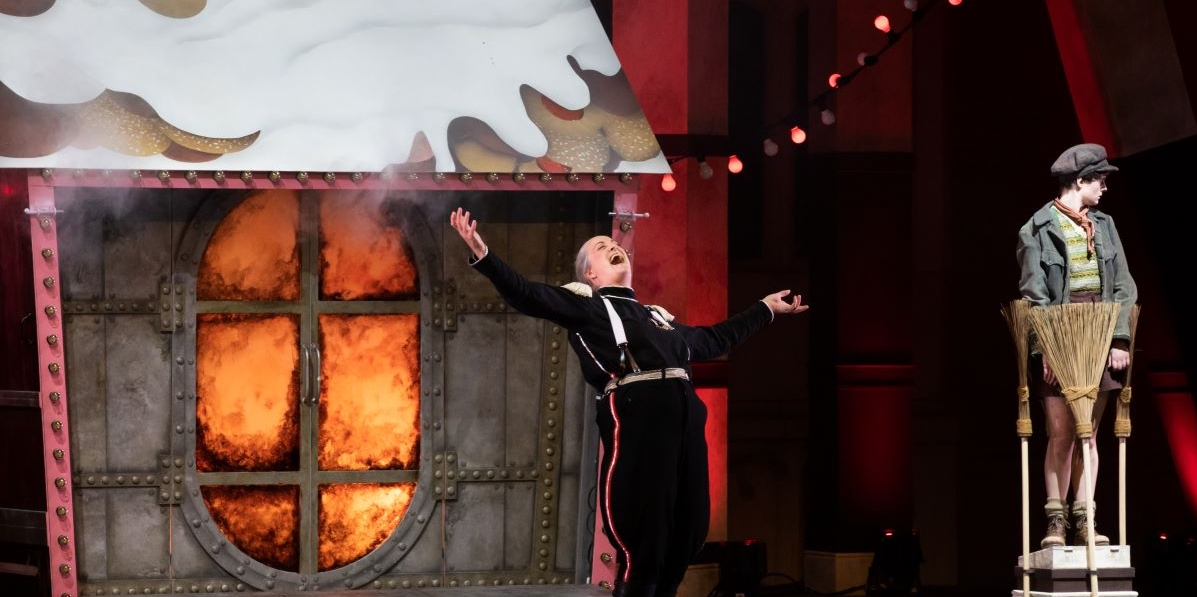Holland Park is a great setting to see an opera in the summer, and we are all lucky that the weather on the whole has been good. There is no public funding and it is remarkable that operas of this standard can be seen. It is a good place to dip your toes in your first opera, and this one is particularly good for children.
Humperdinck’s Hansel & Gretel is a tricky opera to produce nowadays. Humperdinck was a great admirer of Wagner, worked with him in Bayreuth, and would have been aware of Wagner’s antisemitic views. Whereas this German tale is a starter opera for children, the children’s fairy story hides a sinister darkness beneath. A recent Met opera production went as far as transforming the inside of the Witch’s house into a gas chamber/crematorium; after all, Germany did burn millions in ovens. It is good that it is sung in the original German, as it adds to the darkness.
John Wilkie intelligently sidesteps these problems with a clever twist of his own.
When we first meet the Witch, she is Marlene Dietrich in a glittering glamourous red gown. Observant watchers may have noticed two Marlene Dietrich posters behind the soon-to-be-spilt milk jug by the caravan. They already know her, so it is understandable they go into her house. Once the children are trapped in her house, she strips the gown becoming a black-uniformed goosestepping Fascist/Nazi, although it is not clear whether ‘she’ becomes a ‘he’. The tables are turned as it is the goosestepping Fascist/Nazi burnt in the oven, who returns baked as a cake. This is a brilliant way of acknowledging the uncomfortable message of the story, and showing what Nazism/Fascism is really about when the glamour and glitz is stripped away.
The Father, Peter, seems to be the most likeable person in the opera. Until he sings his aria describing the witch flying through, seeking out, trapping and cooking children to be eaten as gingerbread. This is a thinly-disguised allusion to the blood-libel levied by antisemites. Children wouldn’t notice, adults might. This is something that Wilkie couldn’t sidestep, but had to leave as it was written.
The opera starts when the children go to sleep and is one of numerous choreographed orchestral interludes; dancing creatures also move the set, a good way of keeping children interested. The choreographed children’s dreams and nightmares are magical.
The sets are not elaborate, but work well. The caravan/hovel where the children live as travellers, swivels to become Witch’s gingerbread house, complete with a large roaring oven.
What makes this production so good, is the quality of the singers.
The stand-out performance is by Welsh-Irish bass-baritone Paul Carey Jones as Peter, the father. This is luxury casting as his high-quality Wotan is well-known. His booming glorious voice is heard from outside the large tent as he arrives on a bicycle, singing La-lare-la, and the mood instantly lifts.
British soprano Meeta Raval is a close second, but only because she does not have as much to sing. She was a finalist in 2011 Cardiff Singer of the World, and has a glorious voice. What a privilege to hear her as Gertrud, the mother who spills the milk and throws her children out into the woods in a fit of temper.
British Charlotte Badham as Hansel, is lucky to be slim, because as a mezzo, she can convincingly sing boy parts such as Hansel or Cherubino. She is a good singer and actress with promising future.
Latvian-Ukrainian soprano, Laura Lolita Pereŝivana is perfect as Gretel. Her voice has gorgeous warm timbre, and she is a convincing actress. She is a name to watch.
Together they make a great brother and sister team, childishly fighting and dancing – ‘brüder komm und tanz mit mir’ but fiendishly protective of each other. The evening prayer is beautifully sung.
Scottish soprano Eleanor Dennis sings a terrific Witch; she makes the most of the excesses in the part. How good to hear a woman singing the Witch, instead of a man, as is usually the case.
April Koyejo-Audiger as the Sandman, charmingly arriving in a wheeled-bath carriage, and Charlotte Bowden as the Dew Fairy both grabbed their opportunity to shine.
Kărin Henderson knows what do with the music, and brings out the shimmering magic of the score.
It is a sad reflection of the state of opera in UK, that most of these stunning singers struggle to get enough work here, because there is none. When the ENO closes it will be worse. There is plenty of work abroad where opera is treated as a serious art form.

